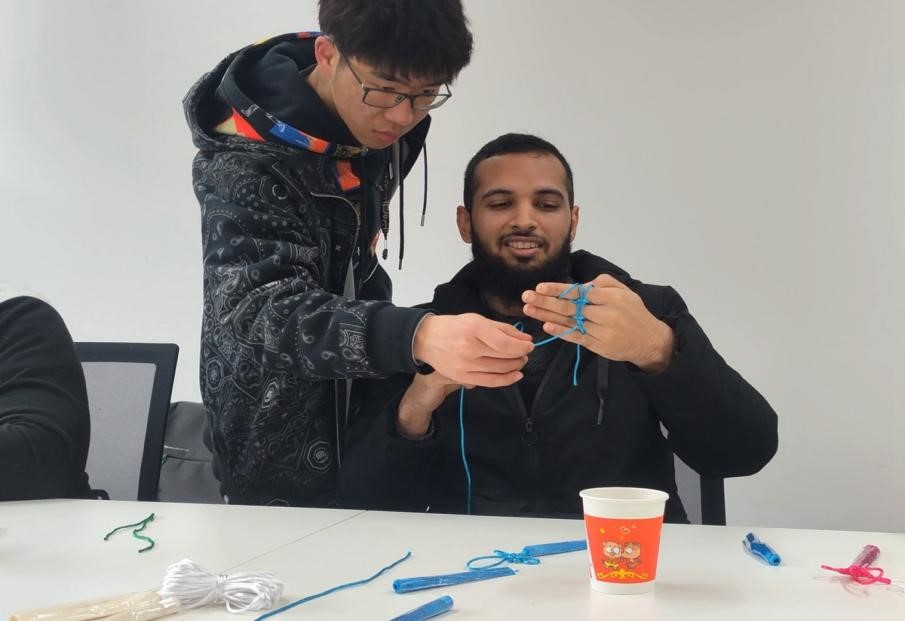On May 14, the short video “Inheritance and Connection: My Encounter with Chinese Knots” won the first prize (ranked 5th in China) and the Best Creativity Award (the only one in China) for the national final of the 1st Higher Education Press (HEP) Short Video Contest themed on “Stories of China in English”. HZAU also won the Outstanding Organization Award for the contest.
Under the guidance of Yang Zhaoyan and Wu Meilin from the College of Foreign Languages, the award-winning video was made by students (Li Ding, Fang Wentian, Dong Gen, Wang Zhennan and Chen Ming) from the College of Informatics.

Team members [Photo/College of Informatics]
Based on team leader Li Ding’s real-life experience, this video tells the story of how he learned, improved and promoted the art of Chinese knot making, vividly illustrating the spirit and culture behind this intangible cultural heritage (ICH).
Born in Yunnan, Li Ding learned simple knot-making skills from his grandparents at a young age, which started his remarkable encounter with Chinese knots. In spare time, Li Ding would make various kinds of Chinese knots by himself. Gradually, his friends also showed an interest in Chinese knots, though the complex skills often discouraged them.
In order to better spread the culture of Chinese knots, Li Ding began to think about how to simplify the complex process of knot making. Chinese knots are closely related to topology, so he made use of the computer science to study the topological structure in knots. Finally, Li Ding created a simplified “knot-making method”, showing a perfect fusion of science and art.

Knot making [Photo/College of Informatics]
Li Ding’s team consisted of 5 non-English majors, and they encountered a lot of difficulties during the contest. In addition to the teamwork, the support of the teachers from the College of Foreign Languages was the key to their final success.
First of all, the contest required a high quality of English in subtitles, dubbing, PPT and presentation. After translating the video subtitles from Chinese to English, Li Ding found that his translation was only “faithful”, but neither “expressive” nor “elegant”. Under the guidance of the instructor Yang Zhaoyan, the polished English text was accurate, fluent and elegant. Secondly, contacting with foreign friends was also a barrier. After receiving Li Ding’s request for help, Ms. Wu Meilin, who is involved in foreign language teaching for international students, introduced a number of foreign friends to help out.
In the video, it is impressive that Li Ding and a foreigner made a Chinese knot together. In addition, it was a challenge for the team to communicate with the contest organizing committee and get information. Ms. Wang Fei undertook this task and escorted them to the finals. Li Ding said thankfully, “Whenever we advanced to the next round, Ms. Wang would always encourage us; whenever contest update issued, Ms. Wang would inform us quickly and seriously.”

Li Ding is teaching a foreigner to knot. [Photo/College of Information Technology]
The team also received kind help from other teachers, including Mr. Jiang Kai, who gave suggestions to optimize the design of PPT for the final, and Mr. Yuan Yinfeng, who read the final speech and recorded a video for them.
The kindness and support from teachers brought Li Ding and his teammates great confidence and motivation. Therefore, they not only seized the opportunity, but also faced the challenge bravely. As a result, they presented a perfect version of their work.
In this work, Li Ding presents his own “knot-making method” to reduce the difficulty of knot making to some extent. However, there is still a long way to go in inheriting and promoting the Chinese knot as an intangible cultural heritage (ICH). In the future, Li Ding will still devote himself to the promotion of ICH, so that more people can encounter Chinese knots, understand Chinese knots and love Chinese culture.
Source: http://news.hzau.edu.cn/2022/0520/63382.shtml
Translated by Xu Yuanxin
Supervised by Pan Buhan
